
What’s that smell? If you’ve visited the newly erected Market House or Anderson’s Blacksmith Shop and Public Armoury, you may have noticed something in the air after the buildings were painted. The odor of chicory? A nearby BBQ? Believe it or not, it’s paint! Tar paint, to be exact.
That’s right. The distinct odor is the scent of tar—an inexpensive, waterproof coating that was used extensively in Virginia during the Colonial period. This smell would have been pervasive throughout Williamsburg in the 18th century.
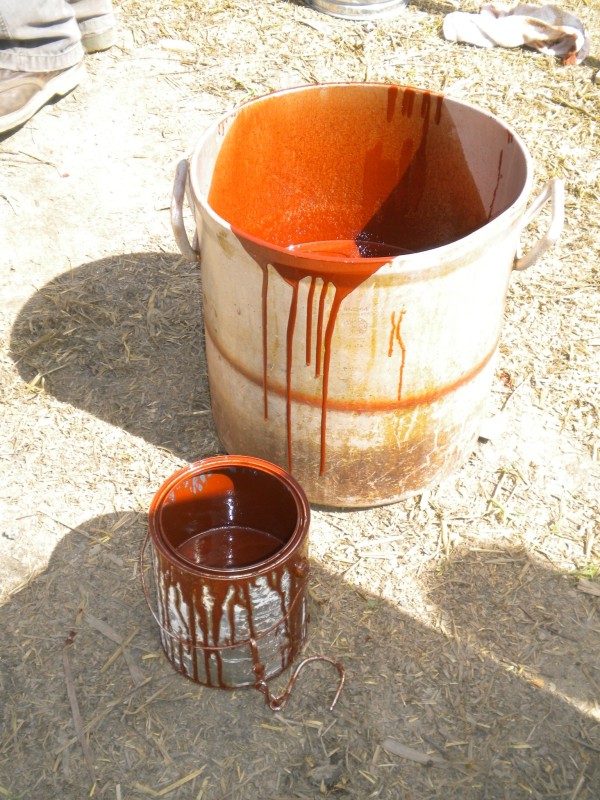 What is tar paint? Tar and pitch were some of the earliest protective coatings used to preserve woodwork in houses, public buildings, and ships and date back to ancient times. Both materials are by-products of the destructive distillation (heating) of softwoods like pine, and birch bark. Both have excellent water-repellent properties which made them very appropriate and economical coating alternatives in the American Colonies, where pine forests were extensive.
What is tar paint? Tar and pitch were some of the earliest protective coatings used to preserve woodwork in houses, public buildings, and ships and date back to ancient times. Both materials are by-products of the destructive distillation (heating) of softwoods like pine, and birch bark. Both have excellent water-repellent properties which made them very appropriate and economical coating alternatives in the American Colonies, where pine forests were extensive.
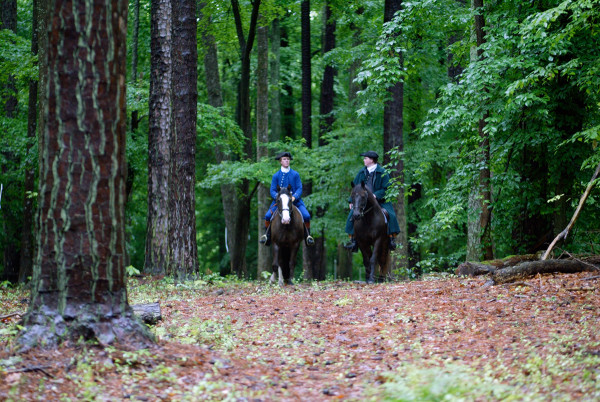
There are hundreds, possibly thousands, of primary references that refer to the use of tar on buildings in Virginia. Here are just a few:
“tarr ye roofes of ye said houses and porch (Lancaster Co.)
“tarring the courthouse and prison” (King George Co.)
“tar the new church at Poplar Spring” (Gloucester Co.)
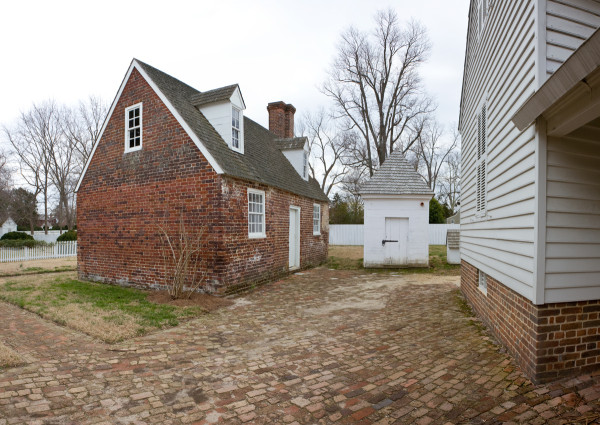
In 1704, a fascinating report on tar production in Virginia was written by E. Jenings for the Royal Commissioners in Great Britain:
“I believe there is Annually made in Virginia near 3,000 barells of Tarr in Princess Ann County wch containes…50,000 acres of low Pine Land, not Agreable for tobacco…What Tarr now made, is of the Knotts and Pieces of fallen Trees…Some is made use of by the Inhabitants for their houses, Boats & c. Part disposed of to the Masters of Ships for their Use, And part Transported to Barbadoes, Jamaica & Seward Islands.”
 Tar was not always used by itself. It could be mixed with pigments and/or oils to protect and also enliven surfaces with color. One such example can be found in a written agreement for the painting of the St. George Tucker House in Williamsburg, dated August 30, 1798:
Tar was not always used by itself. It could be mixed with pigments and/or oils to protect and also enliven surfaces with color. One such example can be found in a written agreement for the painting of the St. George Tucker House in Williamsburg, dated August 30, 1798:
“The top of the Kitchen, and of the shed leading down from the Cellar to the Kitchen yard, are to be painted with Spanish Brown, mixed with Tar, & fish oil, & well boiled together.”
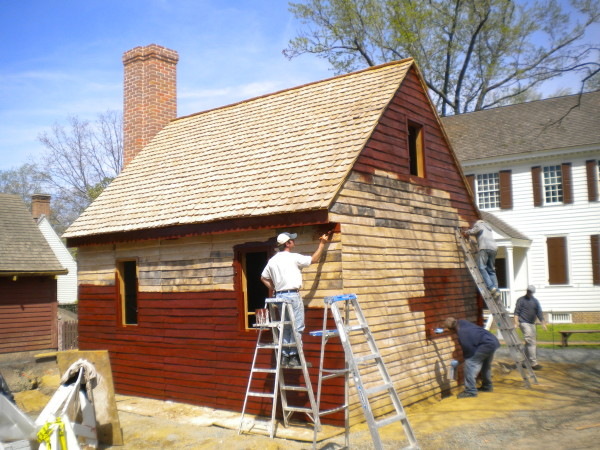 Tar paint must be applied warm. The heat thins the tar, which is immediately soaked up by rougher hewn surfaces such as riven clapboards and shingles. In fact, this is how the Market House roof and the Anderson Armoury kitchen were painted! That deep red color you see is a mixture of tar, oil, and red ochre pigments.
Tar paint must be applied warm. The heat thins the tar, which is immediately soaked up by rougher hewn surfaces such as riven clapboards and shingles. In fact, this is how the Market House roof and the Anderson Armoury kitchen were painted! That deep red color you see is a mixture of tar, oil, and red ochre pigments.
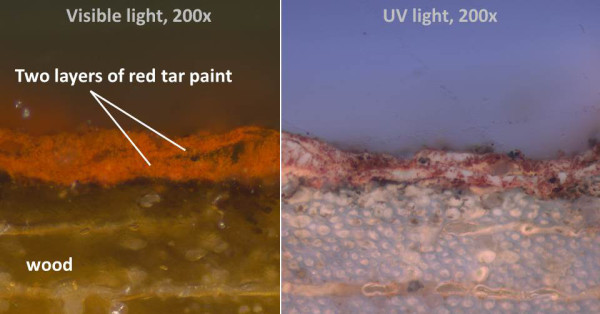 In our Materials Analysis Laboratory, tar paints are evasive (this seems to be a function of age), but they can sometimes be identified using cross-section microscopy and/or Fourier-transform infrared spectroscopy (FTIR). So far, tar paints have been positively identified on exterior weatherboards at the John Blair House and the Thomas Everard Kitchen. It is likely that this versatile coating was used on many more Williamsburg buildings, but over time this thin layer became worn and was painted over with more permanent oil-based paints, obscuring the earlier tar evidence.
In our Materials Analysis Laboratory, tar paints are evasive (this seems to be a function of age), but they can sometimes be identified using cross-section microscopy and/or Fourier-transform infrared spectroscopy (FTIR). So far, tar paints have been positively identified on exterior weatherboards at the John Blair House and the Thomas Everard Kitchen. It is likely that this versatile coating was used on many more Williamsburg buildings, but over time this thin layer became worn and was painted over with more permanent oil-based paints, obscuring the earlier tar evidence.
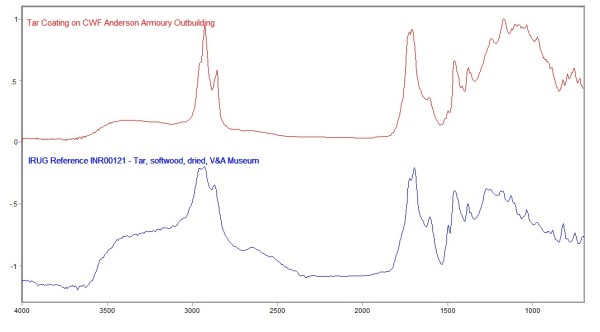 To me, tar is the unsung hero of historic architectural coatings. Our forefathers were certainly aware of this versatile material, and put it to good use. Some of our historic buildings might not be here today if not for the preservative effects of tar! So the next time you are in the Historic Area, please visit the Market House and the Anderson Armoury to see (and smell!), this historically accurate coating!
To me, tar is the unsung hero of historic architectural coatings. Our forefathers were certainly aware of this versatile material, and put it to good use. Some of our historic buildings might not be here today if not for the preservative effects of tar! So the next time you are in the Historic Area, please visit the Market House and the Anderson Armoury to see (and smell!), this historically accurate coating!
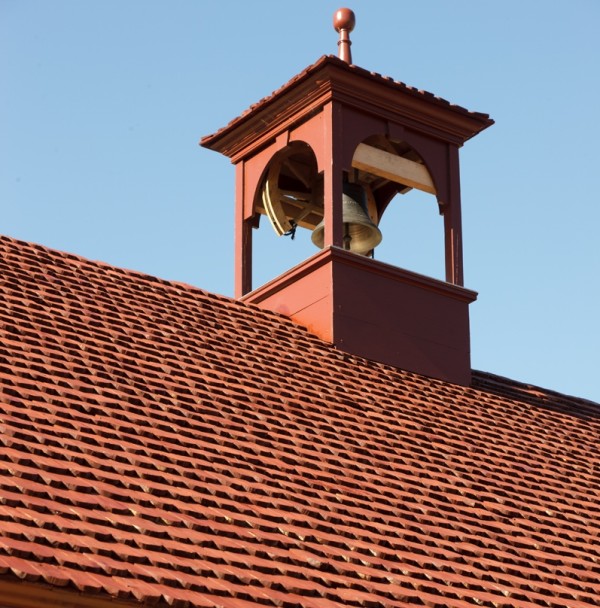
Blogger: Kirsten Moffitt
 Kirsten received her M.S. from the Winterthur/University of Delaware Program in Art Conservation, where she specialized in the conservation and analysis of painted surfaces. As Colonial Williamsburg’s Materials Analyst and Associate Conservator, Kirsten analyzes all types of collection materials including metals, ceramics, textiles, furniture and house paints in the Foundation’s newly established Materials Analysis Laboratory. She loves that her job is a combination of art history, chemistry, and forensics. Kirsten truly loves watching paint dry, and her analytical work was a big contribution to Benjamin Moore’s Williamsburg Collection line.
Kirsten received her M.S. from the Winterthur/University of Delaware Program in Art Conservation, where she specialized in the conservation and analysis of painted surfaces. As Colonial Williamsburg’s Materials Analyst and Associate Conservator, Kirsten analyzes all types of collection materials including metals, ceramics, textiles, furniture and house paints in the Foundation’s newly established Materials Analysis Laboratory. She loves that her job is a combination of art history, chemistry, and forensics. Kirsten truly loves watching paint dry, and her analytical work was a big contribution to Benjamin Moore’s Williamsburg Collection line.
Kirsten loves reading, traveling, and walking her black lab, Ebbie, around the Historic Area.
Edwin Wrench says
MR AVERY AND CREW DOES A WONDERFUL JOB ALL THROUGH OUR STATE OF NORTH CAROLINA
Bryan Avery says
I am a Historian in N.C. We have a team that travels and makes Tar, Pitch and Turpentine. We have a Huge exhibit and have been all over the State of N.C. I left word in Williamsburg about our exhibit, but no one has called. If Yall are interested in the Real Product Manufacture , E mail me.
Edwin Wrench says
AND MR AVERY DOES A WONDERFUL JOB,THANKS TO ALL THE CREW
Tad Frei says
Hi Bryan,
I hope you’ll see this message! I am an historical folk artist and am very interested in your tar production. I would love to incorporate it in my work for a more authentic piece. Please contact me at tadfrei@yahoo.com or through my artist page on Facebook: Ohio Valley Hornworks.
Thanks!
Kelly Priest says
Kristen,
Thanks for the information. I have been researching old and new uses of tar for some time. I would like locate someone in my area that produces tar (non-commercial) for use in paintings. I’m an artist and enjoy using natural, historical products in my work. Do you have contacts for local producers?
Hi Kelly- Thanks for your question! It is a good one. Unfortunately, off the top of my head I do not know of any natural resources for tar. I will ask my colleagues and see what they can find. Stay tuned!
Bruce Williamson says
Kristen,
I enjoyed reading your blog about tar-paint. I was unfamiliar with it’s use. Are the building shingles wood shake or some type of reproduction? We live in a 25 year old reproduction of the Wythe House which needs a new roof. I’m interested in researching what roofing materials are being used in current restoration/preservation efforts in Colonial Williamsburg. Would you kindly point me in the right direction as to whom I could call?
Hi Bruce, thanks for your interest! I have forwarded your query to our Director of Architectural Preservation. He can tell you much more about roofing materials at CW. Have a great one!
Great article - exciting to see the discovery and use of yet another lost art (of sorts), esp. when it involves a natural non-chemical material. That which keeps stumps from rotting for decades must be an effective preservative
What are the plans if joaquin decides to head for Colonial Williamsburg? Have you ever had to close down?
Don - we are watching the storm closely and plan to keep our social media channels updated with any announcements as they come in!